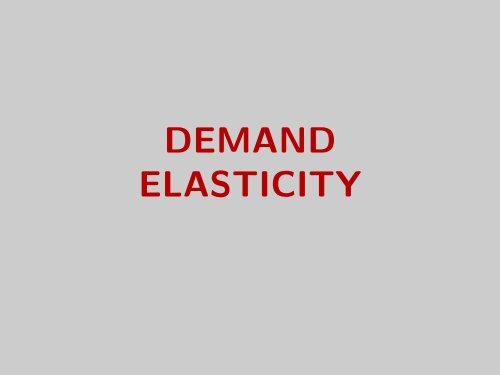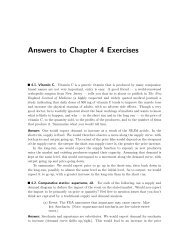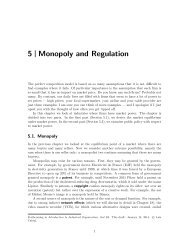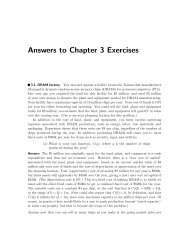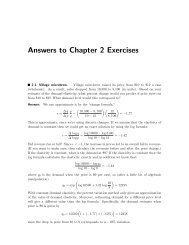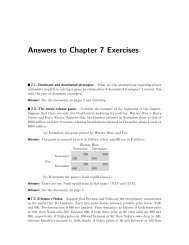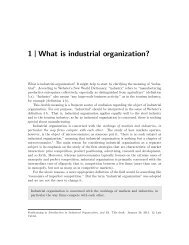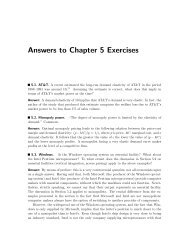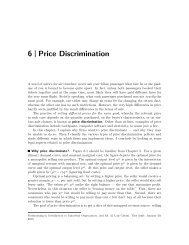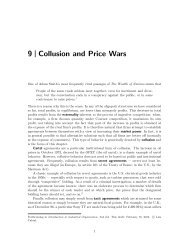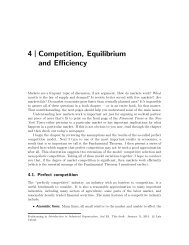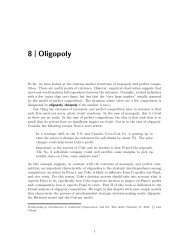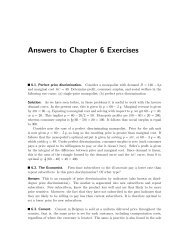DEMAND ELASTICITY - Luiscabral.net
DEMAND ELASTICITY - Luiscabral.net
DEMAND ELASTICITY - Luiscabral.net
You also want an ePaper? Increase the reach of your titles
YUMPU automatically turns print PDFs into web optimized ePapers that Google loves.
Demand elasticity: definitionɛ≡d qqd pp= d qd ppq = d log qd log p
Demand elasticity: definitionɛ≡d qqd pp= d qd ppq = d log qd log p≈∆ qq∆ pp= % ∆ quantity% ∆ price
Demand elasticity: definitionɛ≡d qqd pp= d qd ppq = d log qd log p≈∆ qq∆ pp= % ∆ quantity% ∆ price≈∆ log quantity∆ log price
Demand elasticity: notes• Elasticity and slope are not the same.• Elasticity is independent of units.• Knowing price change, quantity change may be estimated basedon elasticity:∆ qq≈ɛ ∆ pp
ExamplesProductElasticityMilk -0.5Cigarettes -0.5Beer -0.8Apples -1.3US luxury cars in US -1.9Foreign luxury cars in US -2.8
Elasticity illustrated: linear demandp•ɛ = 0|ɛ| > 1•|ɛ| = 1|ɛ| < 1ɛ = −∞•q
Elasticity illustrated: constant elasticitypɛ = −∞|ɛ| > 1ɛ = 0|ɛ| < 1q
Elasticity, price, and revenueRevenue ≡ R = p × q. Therefore:∆ RR≈∆ pp+ ∆ qq= ∆ pp+ ɛ ∆ pp= ∆ p (1 + ɛ)pIf price falls, then:• Revenue rises if ɛ < −1 (that is, |ɛ| > 1)• Revenue falls if ɛ > −1 (that is, |ɛ| < 1)• Revenue is unchanged if ɛ = −1
Elasticity, price, and revenueExamples: for a 1% decrease in price,• Cigarettes: revenue falls approx 0.5% = −.1%×(1+(−.5))• U.S. luxury cars: revenue rises approx 0.9%• Foreign luxury cars: revenue rises approx 1.8%
Revenue change from price decreasepLoss L = q (−∆ p), Gain G = p ∆ qG > L iff p ∆ q > q (−∆ p)iff∆ q∆ ppq < −1∆pqE 1E 2p∆qq
Cross-price elasticity• Idea: How sensitive is demand for your product to prices ofcompeting products? Answer: Cross-price elasticity.ɛ ij =d q iq id p jp j• Jargon:− If ɛ ij > 0, we say i and j are substitutes.− If ɛ ij < 0, we say i and j are complements.− If ɛ ij = 0, we say i and j are independent.• Examples?
Income elasticity• Idea: How sensitive is demand for your product to consumerincome? Answer: income elasticity.ɛ y =d qqd yy• Jargon:− Inferior good: ɛ y < 0− Normal good: ɛ y > 0− Necessity: 0 < ɛ y < 1− Luxury: ɛ y > 1• Examples?
Example: U.S. gasoline demand (cont)
Example: gasoline demand• Based on U.S. data from 1953–2004,whereln q = −16.1 − 0.03 ln p + 1.17 ln y − 0.33 ln c + 0.85 ln nq: gasoline consumptionp: gasoline pricey: per capita incomec: price of carsn: population• What is the gasoline demand elasticity? Income elasticity? Crossprice elasticity w.r.t. cars? How do you classify the good“gasoline”?
Example: gasoline demand• From 1953 to 2004, p, y, c and n increased at the followingannual rates: 3.9, 2.2, 2.0, 1.2%. How much do you expectdemand to have grown?• Recall that d zz∆ qqd x= ɛ zx x, for any z and x. Hence,= −.03 × 3.9% + 1.17 × 2.2% − 0.33 × 2 + .85 × 1.2%= −.117% + 2.574% − 0.66% + 1.02%= 2.817%• Note: actual growth rate was 2.7%.
Takeaways• The elasticity (of demand) measures sensitivity of buyers tochanges in price.• It’s useful for computing impact of price changes on quantity andrevenue.• Cross-price and income elasticities measure sensitivity to otherfactors.


